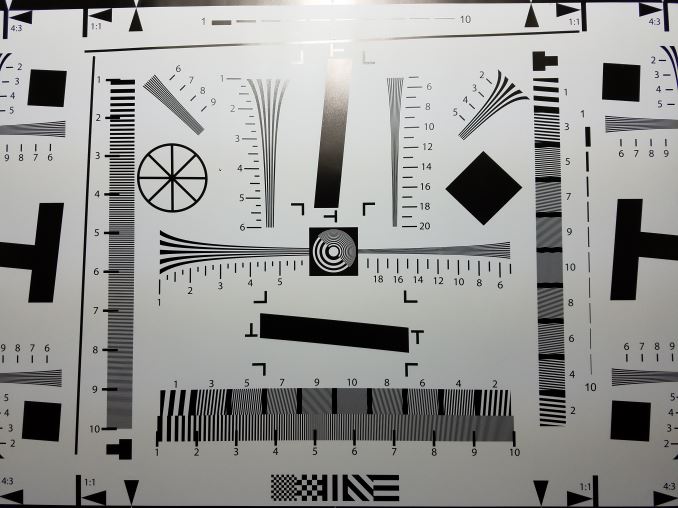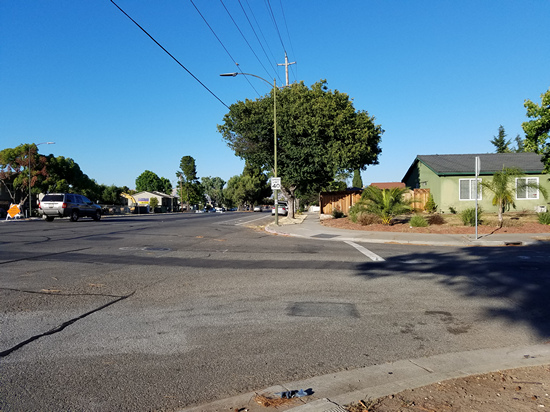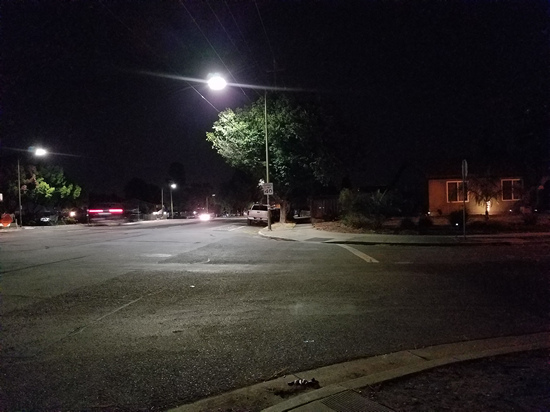The Samsung Galaxy S7 and S7 edge Review: Part 2
by Joshua Ho on July 5, 2016 8:00 AM ESTStill Image Performance
Now that we’ve covered the user experience associated with the camera, we can start to go over the output that the Galaxy S7 is capable of producing. In order to do this we continue to carry over the same sorts of benchmarks that we’ve used in 2015, which is to say that we use a combination of standardized test charts with semi-controlled lighting along with real world testing to try and see how the device actually performs outside of rather simplistic tests.
Starting with the ISO chart we can see quite clearly that the Galaxy S7 has lost noticeable ground in resolution relative to the Galaxy S6 when you look at the center of the photo, but at the edges of the photo the Galaxy S7 actually appears to have the lead against the Galaxy S6. The same sort of story plays out with the HTC 10 as it clearly has more detail than the Galaxy S7 at the center of the photo but the edges of the HTC 10’s test chart shot shows clear defocus that gets pretty terrible at the corners.
| Daytime Photography |
In our daytime landscape test we can see the sorts of effects that the smaller pixel size has had on the Galaxy S7. Relative to the Galaxy S6, there’s almost no delta in the detail resolved, but right away it’s obvious that the sharpening halos have become even more obvious than before which is concerning. These observations also apply to the Galaxy Note5, although the Note5 is a bit sharper due to some changes in image processing relative to the Galaxy S6. However I wouldn’t say that there’s an appreciable difference one way or another here.
Relative to the iPhone 6s, the Galaxy S7 is basically identical in detail as well, but the iPhone 6s tends a bit warmer and has much, much less obvious post-processing that is extremely obvious on the distant trees that contrast against the sky. This is actually kind of surprising for me given that the Galaxy S7 has a larger sensor, but I suspect the dual pixel AF, wider aperture, and slightly wider field of view are eliminating whatever advantages increased sensor size might bring.
Compared to the HTC 10, the Galaxy S7 has better edge contrast, but generally it looks like textures have better detail on the HTC 10. I haven’t been able to do extensive RAW comparisons yet but it looks like HTC is just blurring luminance noise out too aggressively here for whatever reason. I’m not sure what causes this in image processing, but given how other OEMs like LG and Apple are fully capable of mostly eliminating color noise from their photos while retaining most of the detail that their cameras are capturing HTC would do well to do the same.
The final point of comparison I want to make here is the LG G4/G5. Although the G5 seems to have started an AF run in the middle of the capture, the areas where the photo is actually focused are arguably better than what the Galaxy S7 can put out. Even next to the G4, the Galaxy S7 falls short. I’m honestly not sure why LG doesn’t get more credit here, because next to Apple they seem to have the best image processing algorithms in the industry.
| Low Light Photography |
While daytime quality is critical, I suspect most people are going to be interested in low light performance as this is usually the hardest test for any OEM to get through. It’s taken years for OEMs to start shipping acceptable image processing in low light that wasn’t just a smeary and oversharpened mess, so getting this right is pretty important to say the least.
Unfortunately, the Galaxy S7 is just a bit disappointing here. The LG G5 is just clearly better here as noise reduction is better in pretty much every way and it looks a lot more natural due to less obvious sharpening halos. I would also argue that the HTC 10 is also better here due to its better texture detail and better handling of shadow detail, even if edges are softer.
The Galaxy S7 also has this strange streaking light flare with bright sources that I just couldn’t get rid of despite wiping the lens multiple times with a clean cotton cloth, which was done for every phone in this test before taking the picture. In fairness, the Galaxy S7 is still the fastest camera out of everything in this test, but it comes at the cost of rather disappointing output for me. The Galaxy Note5 looks like it might even be slightly better than the Galaxy S7, which is a weird regression when the general idea of going to a larger pixel size is to get better low light performance. As alluded to earlier, the cost of the dual pixel AF system may be sensitivity due to the dual photodiodes and light barrier to generate a phase detection pixel. While this is just one test example I’ve spent a lot of time playing with the camera on the Galaxy S7 and in general its low light performance is fairly similar to what you see above. The only time where I really see the Galaxy S7 lead is in extreme low light conditions where everything is reaching ISO and shutter speed limits.
Overall, while the user experience of the Galaxy S7's camera is industry-leading, the Galaxy S7 represents a somewhat unfortunate sidegrade in camera quality at best. I would argue that Samsung has gone in the wrong direction with their camera processing as they seem to be relying on strong noise reduction and sharpening more than ever before. The Galaxy S7 also retains the oversaturated color rendering of the Galaxy S6. While I'm sure most people are happy with these results, Apple and LG tend to have more accurate color rendition with their cameras. While HTC doesn't quite nail color rendition, they are arguably closer to reality than Samsung is. Hopefully with their next device they manage to maintain their class-leading speed, but with better post-processing and overall image quality.



















266 Comments
View All Comments
virtuastro - Wednesday, July 6, 2016 - link
Exactly. My friend bought the S7 for the camera. We tested together between the S6 16mp F/1.9 (my phone) and S7 F/1.7 12mp 1.4 µm. Autofocus is indeed faster on S7 than the S6. Still Image quality and Low-Light still better on S6 for the most part. The LG G4 and G5 both still use 16mp and great in low-light as well. I am not going to upgrade GS7 but waiting for next year. Hopefully Samsung need to back at 16mp F/1.7 to F/1.9 might add more faster autofocus. P.S. English is not my first language.lilmoe - Wednesday, July 6, 2016 - link
Provided sensor technologies are similar, the size of individual photosites don't matter really, what ultimately matters is the size of the sensor (the total amount of light captured) and the speed of the lens.Lower resolution images are better for faster and more fine-tuned post processing.
Impulses - Thursday, July 7, 2016 - link
Buying any high end phone largely on the basis of it's camera, particularly if you already have a decent 1-2 yr old flagship phone, is a huge waste of money IMO. The same kind of money gets you so much more in a dedicated camera, whether it's a P&S, DSLR, or compact mirrorless ILC.Smartphones killed low end small sensor P&S cameras, that market was essentially gutted (and with good reason as it was quite stagnant), but they're still far far behind anything else.
beginner99 - Wednesday, July 6, 2016 - link
"There are clear points of differentiation between the Galaxy S7 and OnePlus 3 or Mi5 in terms of features, but I don’t think it’s enough to be worth the $300"True but it's war from $300 if you look at real prices at which you can buy the phones especially international version. I was very interested in the Mi5 but now that it is finally available here much less so. The 64 GB variant is about $30 cheaper than the 32 gb S7 (international). The later however is water-proof, has an sd-slot and more importantly also more LTE bands, better screen and camera plus it's less risk in general and higher resale value because Samsung. (The 32 gb mi5 has a slower SOC). Even though it kind of hurts me to go Samsung which everyone else has here that doesn't have an iPhone, it's the phone that suits me best. What also concerns me, is that benches you show here don't show the whole truth. Look at below comparisons. The S7 is just way faster in real-life:
https://www.youtube.com/watch?v=vR2zq5I3i4g
tansnhands66 - Wednesday, July 6, 2016 - link
I never had the 6 but there were a lot of little things I miss from the 5 and the Note Edge. Texting lost a lot like no delayed sending, no "send now" on scheduled texts, no editing scheduled texts,and no repeat timed notification reminder . And for the calendar, no timed snooze setting (10,15, etc. minutes) and no "go to date" option. And don't get me started on the ONLY tone for the timer. It sounds like "Bedonkadonk, Bedonkadonk". Very annoying.Meteor2 - Wednesday, July 6, 2016 - link
For some reason I decided to read the comments before the article and... are we reading the same review? Joshua, this is a well-balanced, accurate and fair review. I don't like iOS but bottom line is top-drawer Android is well behind Apple. I love my Nexus 5X for its display, UI, and value. Flagship Android phones are poor value right now.KoolAidMan1 - Sunday, July 10, 2016 - link
Anandtech always has been and remains one of the most unbiased, objective sites out there.Some people see that a GS7 gets BTFO by even the iPhone SE and their brains break. It just doesn't compute that "Crapple" continues to deliver with the best hardware so they have temper tantrums and call AT biased shills.
Its so childish. If these people would use empirical data instead of their personal emotional bias they might learn something.
darkich - Wednesday, July 6, 2016 - link
"when themes can have noticeable effects on performance and battery life".. WHAT KIND OF BS IS THIS, AT!?!?Michael Bay - Wednesday, July 6, 2016 - link
Surprised by this?Try using your head then, it helps.
darkich - Wednesday, July 6, 2016 - link
Oh really..Themes affect the performance and battery life in such minor extent that pointing it out on a supposedly the most professional tech site is utterly ridiculous.
I used themes on my phone since Symbian OS! And even then the effect on battery endurance and performance has been unnoticeable.